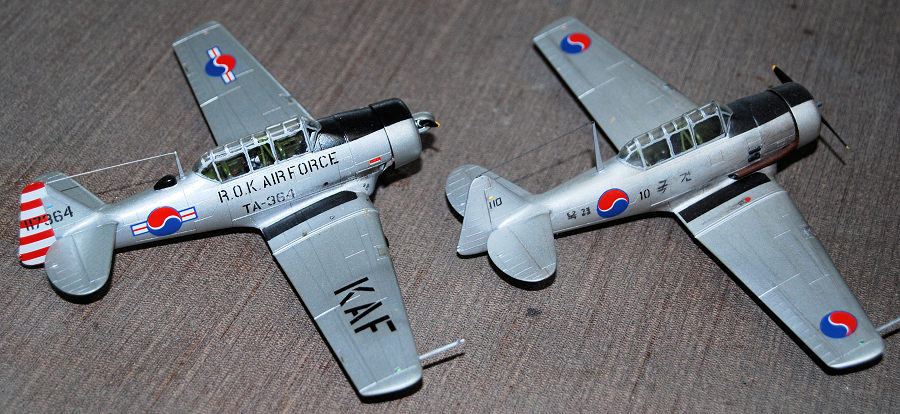
| KIT #: | 1662 |
| PRICE: | ~$15.00 |
| DECALS: | Three options |
| REVIEWER: | Christopher Campbell |
| NOTES: | A well molded, easy build kit |

| HISTORY |
The history of the T-6 and its many variants has been well documented and is doubtless familiar to most who frequent this site. Therefore, this history will be brief and principally focus on the Harvards and T-6’s used by the Republic of South Korea Air Force in its formative years through the Korean War and its immediate postwar years. In short, the North American T-6 traces is ancestry back to the NA-16 prototype created in 1935, which North American entered into the U.S.A.A.C. competition for a new trainer aircraft. In an era during which almost all trainers in use in the world were fabric covered biplanes, it was virtual a quantum leap forward.
The aircraft went through a number of design permutations, including the BT-9, a fixed landing gear variant which was built in limited numbers. What would eventually become the well known as T-6, AT-6, SNJ, and several other designations, would enter U.S.A.A.C. service as the BC-1, an enclosed cockpit, two seat, all metal monoplane trainer aircraft fitted with a nine-cylinder air cooled Pratt & Whitney R-1340 Wasp engine driving a variable pitch, two-blade propeller. It was almost immediately recognized as being head and shoulders above other contemporary trainers and both domestic and foreign orders began pouring in.
The U.S. Navy quickly began acquiring the aircraft as well, designating them as the SNJ. The U.S.A.A.C. began designating them as AT-6 in 1939 and both services began ordering specialized variants which included gunnery trainers, bomber trainers, and even an attack variant designated A-27. This last variant would see action in the Philippines, where a number initially ordered by Thailand were commandeered by the U.S. Army Air Corps and fought to the bitter end against the Japanese invaders.
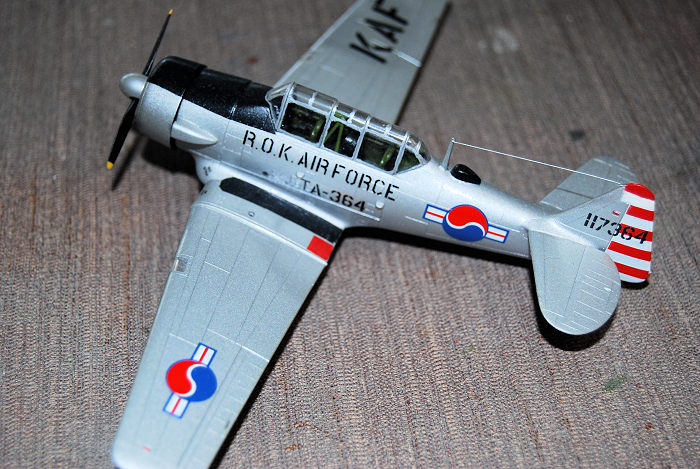 Field
conversions of T-6’s to attack aircraft would prove to be quite common,
especially by shore based U.S. Navy and Marine squadrons in the Pacific. A
variety of improvised gun and bomb mounts were used that are too numerous to
list. What had started life as a trainer proved to be a very capable improvised
strike and later forward air control aircraft. The T-6 was proving itself quite
the jack of all trades.
Field
conversions of T-6’s to attack aircraft would prove to be quite common,
especially by shore based U.S. Navy and Marine squadrons in the Pacific. A
variety of improvised gun and bomb mounts were used that are too numerous to
list. What had started life as a trainer proved to be a very capable improvised
strike and later forward air control aircraft. The T-6 was proving itself quite
the jack of all trades.
It was first license for foreign manufacture came from Australia, where it was produced as the CA-9 Wirraway, starting in 1939. In this guise it would serve the R.A.A.F. well. This stayed essentially true to the T-6 design, though featured and aft fuselage of doped cloth over metal framing similar to the Hawker Hurricane. Fitted with a forward firing .303 machinegun and a flexible mount in the rear cockpit, it even scored a confirmed kill of a Ki.43 Oscar.
It was built in great numbers under license in Canada as the North American Harvard, some of which would later find their way into the fledgling R.O.K.A.F. in the late 1940’s. More than 1200 would be produced, many of which would find their way to the R.A.F.
While its wartime use was principally confined to U.S. and the British Commonwealth, and lend lease aircraft provide to the Soviet Union, postwar it would be seen around the globe. It would go on to serve as a primary trainer in the U.S. well into the 1950’s and beyond, eventually being superseded by similarly numerous variants of its North American successor, the T-28 Trojan and finally the Cessna T-37. It would serves as a trainer in a multitude of air forces until South Africa finally retired them in 1995.
Adept as a forward air control, light strike, and counter insurgency aircraft, it could be found in virtually very postwar conflict for decades. As such, it saw extensive use by France in Algeria, the Congolese wars, and by Spain and Portugal in their wars to retain colonial possessions in Africa into the 1970’s. The last combat AT-6’s saw action in Portuguese Colonial Wars, ending their service as frontline aircraft in 1975.
Its potential as a forward air control aircraft began with the genesis of this concept of coordinating ground strikes during late W.W.II. While on European battlefields this task was largely relegated to numerous Piper L-4 Cubs already in theater, it was the SNJ that found itself tasked with this more often in the Pacific. The concept of forward air control was further refined during the Korean War where the T-6 and Lockheed T-33 were frequently the aircraft of choice and during this conflict it did yeoman’s work. They also saw action in this role in the India-Pakistan wars, Israeli conflicts, and others, to be certain.
An additional wartime and later postwar role would find it most unexpectedly being used as stand in for the Mitsubishi A6M Zero, due to a notable similarity. To my knowledge, the first such use was in the 1945 wartime biopic film God is My Copilot about legendary aviator Robert L.Scott, where the main modification was to overpaint the aft canopy and apply Japanese insignia. However, many would be more accurately modified as Zeros with altered canopies and wingtips, eventually becoming very realistic stand-ins and would be seen in numerous films and television shows set in the Pacific Theater. Use of improved CGI aside, this will likely continue for years to come. Likewise, it is a regular on the warbird circuit, a trend that shows no sign of abating. With in excess of 15,000 aircraft being produced, it can be found in museums around globe and as well as in the hands of numerous private collectors and aviators.
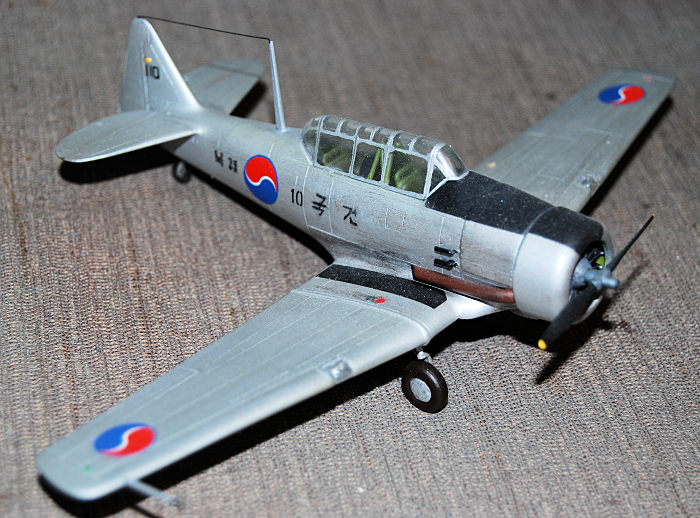 When South
Korea gained her independence at the end of World War II, the nation was left in
a tenuous position. She was a fledgling nation with a hostile neighbor to the
North, bent on unifying the peninsula. To be fair, much the same sentiment
existed in the South. Both nations considered themselves, and somewhat arguably,
continue to consider themselves to be the sole legitimate government of this
disputed peninsula, with this being an ongoing source of conflict and
confrontation, most notably in 1950, with the beginning of the Korean War.
When South
Korea gained her independence at the end of World War II, the nation was left in
a tenuous position. She was a fledgling nation with a hostile neighbor to the
North, bent on unifying the peninsula. To be fair, much the same sentiment
existed in the South. Both nations considered themselves, and somewhat arguably,
continue to consider themselves to be the sole legitimate government of this
disputed peninsula, with this being an ongoing source of conflict and
confrontation, most notably in 1950, with the beginning of the Korean War.
South Korean found itself in the unenviable position of forming a new nation after decades of Japanese occupation. While the Republic of Korea army was provided with basic small arms and equipment to form the kernel of a defensive force that would evolve into finely honed military that it is today, there was virtually no provision for a South Korean air arm.
South Korea found herself with a handful of abandoned, largely derelict Japanese types, some of which were made serviceable, at least temporarily, and a handful of American liaison types, principally Piper L-4 Cubs. These Cubs quite notably made a most impressive stand against the invading North Korean forces in 1950, disabling or at least temporarily knocking out several North Korean T-34 tanks using hand tossed bombs much the manner of steely nerved W.W.I aviators. This was no small feat, to say the least.
However, the poor state of the R.O.K.A.F. was readily apparent to those in charge of procurement, such as it was in the pre-war years. While South Korea was, in principle, under U.S. protection, the found themselves unable to obtain much needed aircraft. There was, reputedly, a proposal to provide Lockheed P-38’s at one point. These might have provided a rather nasty welcome for intruding North Korean Yak’s. However, these, or any other fighters, never materialized. Even trainer aircraft were not forthcoming.
A dozen Canadian-built Harvards would eventually be purchased somewhat circuitously from Canada. They would be the only relatively modern, front-line aircraft in anything approaching good order when war finally dawned. At least one was even modified into a float plane, using the float from either a Japnese A6M2-N Rufe or possibly another type (This is still debated, though a photo does exist).
The efforts of Col. Dean Hess to modernize and establish a modern air force in South Korea are well known. A dozen P-51’s would be followed by more. There would be more T-6’s,, T-6G’s, directly from U.S.A.F. stocks, Curtiss C-46’s, Stinson L-5’s, Cessna L-19’s, and more, culminating in the first jet fighters, North American F-86’s, like those that had wrested control of their airspace known as Mig Alley from the Communist aggressors. Still, in many ways, the modern R.O.K.A.F. began with this handful of Canadian built Harvards. From this it would grow into one of the most formidable air forces in Asia, which it is today.
| THE KIT |
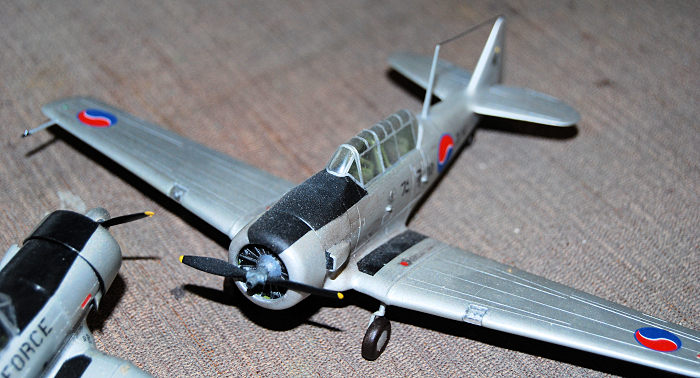 Academy
released their 1/72 North American T-6G Texan kit in 1998. Up until that time,
there had been two principal T-6 or SNJ kits available in 1/72 scale. These were
the Hawk (later Testors) kit from 1955, the Airfix mold shared with Heller,
dating from 1962. The old Hawk kit has admirably, for its period, recessed panel
lines, though is notably deficient in overall details and many releases feature
decal locators. The Airfix kit has more detail in general, though features
somewhat overdone, raised surface detail. Neither has what could be an
acceptable cockpit, though what is provided in the vintage Hawk kit is nothing
more than a pair of benches and poorly molding pilot figures.
Academy
released their 1/72 North American T-6G Texan kit in 1998. Up until that time,
there had been two principal T-6 or SNJ kits available in 1/72 scale. These were
the Hawk (later Testors) kit from 1955, the Airfix mold shared with Heller,
dating from 1962. The old Hawk kit has admirably, for its period, recessed panel
lines, though is notably deficient in overall details and many releases feature
decal locators. The Airfix kit has more detail in general, though features
somewhat overdone, raised surface detail. Neither has what could be an
acceptable cockpit, though what is provided in the vintage Hawk kit is nothing
more than a pair of benches and poorly molding pilot figures.
The Academy kit features nicely recessed detail on its exterior. It has a well molded engine, landing gear, and everything that one would expect from a modern kit. Most importantly, it has a well done, in scale cockpit with proper seat, instrument panels, and everything that a modeler could reasonably want in a 1/72 scale kit. Clear parts are well molded and quite clear. Decals are provided for South Korean, U.S.A.F., and Israeli aircraft.
This kit is head and shoulders above any other mainstream, 1/72 T-6 or SNJ kit out there. For any shortcomings that one might find, there are resin and photo etch sets out there to address this, if one wishes. Still, out of the box it is definitely the go-to kit for the T-6/SNJ modeler today.
While initially quite common, it has more recently, like a number of Academy offerings, become a little more difficult to find. Still, I see them often on vendor tables at shows and on e-Bay. At one point, I was seeing these in hobby shops in the $12 range and on vendor tables for under $10. Now, as with most everything else these days, the prices have been rising and they often are closer to $20. Even so, one would be hard pressed to find a better T-6 in this scale for the money.
| CONSTRUCTION |
These two builds were done about five years apart. The first one was the built straight from the box as a R.O.K.A.F. T-6G, though aside from the modifications to the latter kit built as pre-Korean War Harvard, the builds were essentially identical, down to the paints used. To that end, I will mostly be chronicling the conversion of the same kit to its an R.O.K.A.F. Harvard.
Around 2008, I was dating a woman from South Korea when I decided to build the Academy offering of the T-6G in its South Korean markings out of the box. This build went simply and without any unpleasant surprises and rewarded me with a nice 1/72 R.O.K.A.F. bird.
About four years later, I was married to a different woman from South Korea who was somewhat perturbed by the Japanese aircraft in my collection, as I do have something of a weakness for Japanese Navy types. I decided to build a few South Korean types, both for my own interest and to appease her to a degree. One of the first subjects that I chose was a pre-Korean War South Korean North American Harvard. This would be relatively straight forward conversions, mainly necessitating a few minor external changes and modified markings.
I built the kit essentially out of the box, aside from adding the Harvard extended exhaust pipe and external venturis. I started by spraying the interior, as I had with the T-6G build in Testors Model Master Interior Green. Instrument panels were painted in Testors Flat Black and details dry brushed in silver, with a few switches and knobs picked out in Flat Red and Flat Yellow.
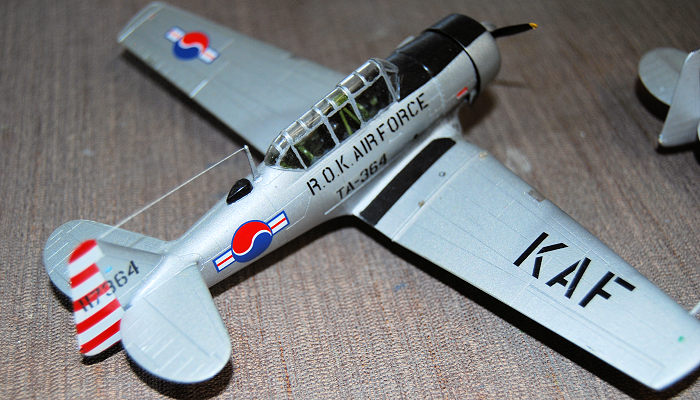 The cockpit
was assembled per the instructions and then fitted to the fuselage. The fuselage
assembly was then glued together with CA glue. This went together very cleanly,
and any filling required was done with a more CA glue applied along the fuselage
seam with a toothpick. This was subsequently sanded with 320 and 400 grit
sandpaper, followed by 0000 steel wool. The wing was assembled without
difficulty, any seams being sealed and sanded in the same manner.
The cockpit
was assembled per the instructions and then fitted to the fuselage. The fuselage
assembly was then glued together with CA glue. This went together very cleanly,
and any filling required was done with a more CA glue applied along the fuselage
seam with a toothpick. This was subsequently sanded with 320 and 400 grit
sandpaper, followed by 0000 steel wool. The wing was assembled without
difficulty, any seams being sealed and sanded in the same manner.
Turning my attention to the engine, this was painted in Testors Flat Black. Detail accented by dry brushing with Testors Aluminum, and the hub painted in Testors Flat Grey. The engine cowl interior was painted in the same Interior Green and everything was set aside for a time.
The wing was then joined to the fuselage with gap filling CA glue. This went mostly without issue, though some minor filling and sanding was required over the landing gear bulges at the leading edge of the wing where it joins the fuselage. This was also done with CA glue and sanded with the aforementioned grits. The horizontal stabilizers went on without issue, only requiring a minimum of sanding after which I was very quickly ready to paint.
| COLORS & MARKINGS |
After giving the model a general buffing with 0000 steel wool followed by a dryer sheet to polish out scratches, I stuffed the cockpit with damp paper towels and sprayed the glare panels in Testors Flat Black. These were then masked off with Tamiya tape and rest of the cowls and exterior given several coats of Testors Aluminum. This was given a full day to dry. While I was waiting, I would work on the landing gear and the propeller.
The wheels were painted in Testors Rubber. Once dry, the hubs were hand painted in Aluminum and the brake drums in Testors Rust. The latter were then given a light dry brushing in Testors Model Master Burnt Iron. The landing gear struts were painted in Testors Aluminum with the oleos painted in Testors Silver.
Once I was satisfied that everything was sufficiently cured to handle, the engine and cowl were fitted in place along with the hub spinner for the propeller, though this was not yet added. The wheels and landing gear were fitted and the whole thing was given a coat of Testors rattle can Gloss.
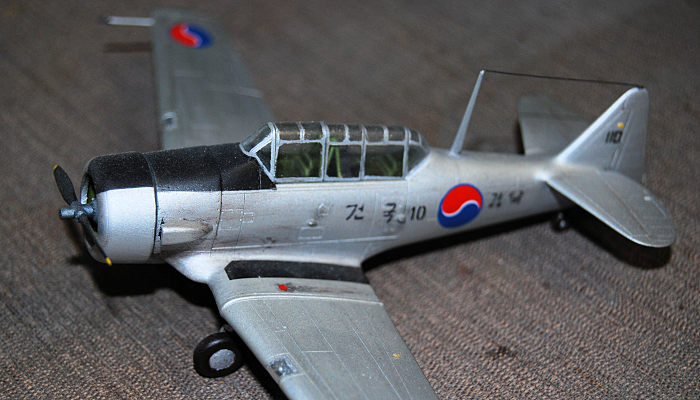 While I
waited for this to dry, I turned my attention to the propeller. Photos of
the Harvards showed no prop spinner as seen on later T-6’s, and they
appeared to have a hollow hub, as if fitted for a Hucks-type starter. This
was addressed by drilling out the hub of the kit prop with an appropriately
sized bit chucked in a pin vise. While something of a modeling “white
knuckle” moment, all went well.
While I
waited for this to dry, I turned my attention to the propeller. Photos of
the Harvards showed no prop spinner as seen on later T-6’s, and they
appeared to have a hollow hub, as if fitted for a Hucks-type starter. This
was addressed by drilling out the hub of the kit prop with an appropriately
sized bit chucked in a pin vise. While something of a modeling “white
knuckle” moment, all went well.
The propellers were sprayed in Testors Flat Black and with yellow propeller warning tips painted in Testors Flat Yellow. Once dry, the propeller hub was painted in Testors Model Master Dark Anodonic Grey. The spinner for the T-6G was sprayed in Testors Silver. This was then glued in place on the propeller hub with a drop pf CA Glue.
Prewar South Korean national insignia was a roundel of the red and blue yin and yang symbols from the national flag and still at the center of the national insignia today. There were no bars present though. These were carried in six positions on the wings and fuselage. These were sourced from two of the Academy T-6 decal sheets, the bars being carefully trimmed away. The decals snugged down very nicely with only a small application setting fluid.
While the from the box T-6G in later R.O.K.A.F. markings had all the decals that I needed, this one was going to require some rather creative solutions to its unique markings. There photo from the Squadron in Action book showing this aircraft, as well as Internet searches showed a number 10 on the fuselage and a 110 tail number. That was simple enough to obtain from the decal number files.
However, there were Korean characters painted on the fuselage for which I had no source. I briefly considered trying to print them myself. Doing so proved problematic at best. I had no font to work with and I had no idea what I was actually printing. My ultimate solution was bit on the edgy side.
I decided that the only real option was to hand letter them. Rather than attempt to paint them, I ultimately chose to write them on using a razor tip marker. This was something that I had to get right the first time, and somehow, I managed it. I asked my wife if they looked right, and after realizing that they were numbers, she confirmed that they were. It worked, but I have to say that it was not something that I want to try again. As to whether or not I would recommend it, given the options, the answer is yes. Still, not something I would like to do again.
I let this “cure” for a while. Then I shot the whole thing is Testors rattle can Dullcote/Flat. As much as anything, this was in hopes that it would seal the marker and I would not accidentally smear it in subsequent handling, as I had no idea how this would react to either the paint or any sort of clear coat. Ultimately, it worked though. I chalk this one up to desperation, gut instinct, and dumb luck, though. While it worked, I am not certain that I would have attempted it again and I have not, to date.
Some minor weathering was added to the Harvard, as photos that I have seen of these aircraft show them to be a bit weather beaten, though not dramatically worn or weathered. This also the reason for flat coat.
Decaling the later T-6G kit was done straight from the box using the kit decals. All responded nicely to decal setting fluid. I have heard some people say that the Academy decals are too delicate for some setting fluids. I have not personally experienced this, I have still taken that as a caution, thus I tend to use MicrSol instead of the stronger Solvaset.
| FINAL BITS |
The only thing left now was to fit some of the “fiddly bits.” Canadian built Harvards had an extended exhaust pipe. This was easily made from a piece of hallow brass tubing. The original exhaust was carefully cut away with a sharp X-Acto blade and its replacement glued into place with a some CA glue after it had been sprayed in Model Master Burnt Iron.
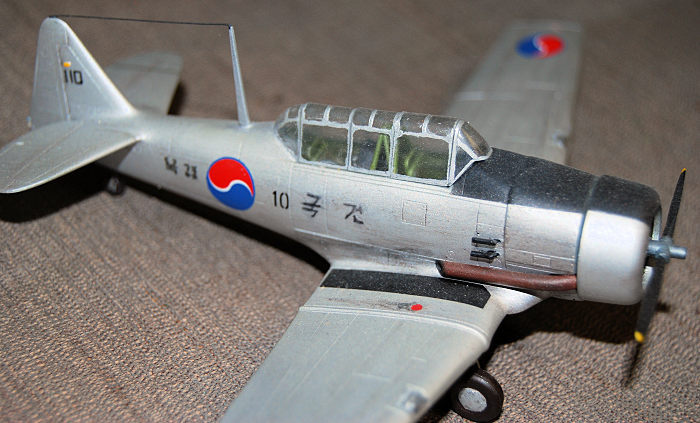 The
landing gear went by the book, the tires painted in Testors Rubber and the
hubs painted in Testors Aluminum. The brake drums were painted. The brake
drums were painted in Testors Rust and then dry brushed in Model Master
Burnt Iron. The landing struts were painted in Model Master Anodonic Grey
with the oleos painted in Testors Silver. Once everything was dry, they were
glued into place with a drop of CA glue.
The
landing gear went by the book, the tires painted in Testors Rubber and the
hubs painted in Testors Aluminum. The brake drums were painted. The brake
drums were painted in Testors Rust and then dry brushed in Model Master
Burnt Iron. The landing struts were painted in Model Master Anodonic Grey
with the oleos painted in Testors Silver. Once everything was dry, they were
glued into place with a drop of CA glue.
Photos of the South Korean Harvard show no landing gear covers, so these were omitted on that aircraft. The covers were slightly tricky to glue into place on the T-6G, as there is no positive attachment point. This was one of the few spots where I had anything that I would describe as difficulty on the model.
The Harvards also featured a pair of external venturis, slightly offset on the starboard side above the exhaust. These were gleaned from something in the parts bin, painted flat black and glued in place. While, later, true T-6’s featured a shorter radio mast, the Harvards had the very tall type, also provided in the kit. This was glued in place and both radio aerials were rigged with stretched sprue. A final coat of rattle can flat was applied to the Harvard, while the T-6 got semi-gloss.
The only thing left was the canopy, both of which were given a dunk Future. The framing was then hand painted in Testors Aluminum using a fine brush and glued in place with CA glue. With that complete, I had both a wartime/post Korean War T-6 and a pre-Korean War North American Harvard and I was very pleased with the results.
| CONCLUSIONS |
The Academy T-6G kits is, in my opinion, by far the best kit out there in 1/72 for any modeler wanting build one of the basic T-6 variants. It is reasonably detailed and has very good fit in most areas. I would recommend this kit to any modeler who wants almost any variant of the T-6 in their collection.
It can readily be converted to a Harvard, AT-6 attack ship, or anything else on might imagine. If one wants a Wirraway or BT-9, I would suggest the MPM kits made of these very unique variants. I have considered building one as one of the A-27’s that fought against all odds in the Philippines and may yet do so. As for South Korean specific variants, the kit can easily be built into any version, even the floatplane, in you have the parts handy. I have very seriously considered building this one as well.
This well designed and reasonably detailed kit by most 1/72 standards has become my go-to kit for this aircraft in this scale. It would make for an excellent first model choice for any modeler who wishes to get into this very popular, though somewhat diminutive scale. I personally grew up building 1/72, and from my perspective, it is almost the perfect T-6 kit. I spent only around eight to ten hours on each model, so it was a quick and easy build. Also, there are almost infinite marking possibilities, as it probably easier to make as list of air forces in which the T-6 or some variant did not serve than those in which it did.
As a note to encourage modelers young and old, there are plethora of mundane, mainstream markings options out there. However, I grew up admiring my Uncle Richard’s model collection that featured numerous, well known, mainstream aircraft in expected markings, as well as quite a few obscure types.
Like myself, he frequently gravitated to more unusual, esoteric subjects; often building models of well known aircraft, but in the livery of obscure air forces and nations. These markings always fascinated me. I encourage all modelers to “explore strange new worlds,” as it were.
Almost everybody has Messerschmitts and Spitfires, for example, in the markings for the nations one associates with such aircraft. Yet isn’t a Slovakian or Croatian 109 or a Burmese or Danish Spitfire a pleasant divergence from the ‘cookie cutter” models of these types. Oddball insignia can be fun, even if challenging sometimes. At present I have four 1/48 De Havilland Vampires in my collection in Lebanese, Zimbabwe, Jordanian, and Indian schemes. All are lovely and pleasant divergences from the ‘norm.” So, have fun and build some unique subjects from lesser known air arms. Researching these markings can sometimes be frustrating, but usually it proves to be an interesting, enjoyable, and educational exercise. It will definitely make your collection more colorful and interesting, both to you and any who might view it, and often more personally rewarding.
| REFERENCES |
T-6 Texan in Action by Larry Davis, 1994, Squadron Signal Publications
https://en.wikipedia.org/wiki/Republic_of_Korea_Air_Force
http://afbase.com/ac2_eddi/353279
21 February 2022 Copyright
ModelingMadness.com. All rights reserved. No reproduction in part or in whole
without express permission. If you would like your product reviewed fairly and fairly quickly, please
contact
the editor or see other details in the
Note to
Contributors.